#corazon aquino
Explore tagged Tumblr posts
Text
EDSA, 38 Years After
On this day in 1986, 38 years ago, the victory belonged to the masses, as they toppled over the dictator that is Ferdinand Marcos Sr. 21 years after his presidency, and, almost 14 years after the declaration of the Martial Law, the people have had enough of his cruelty!
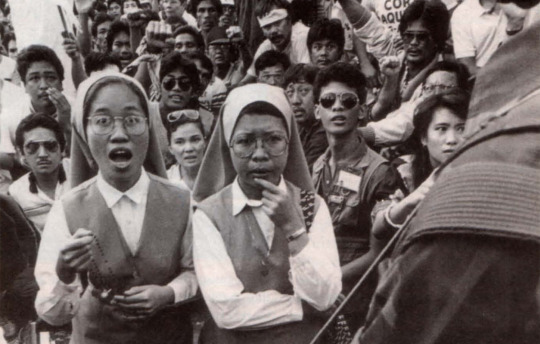
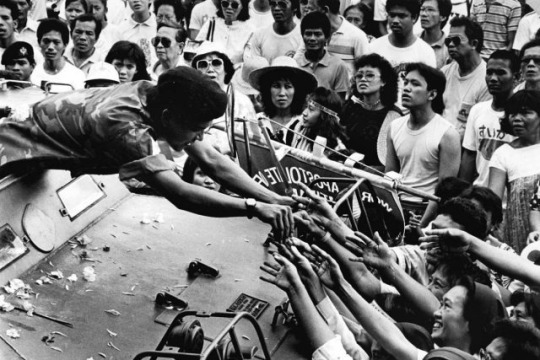
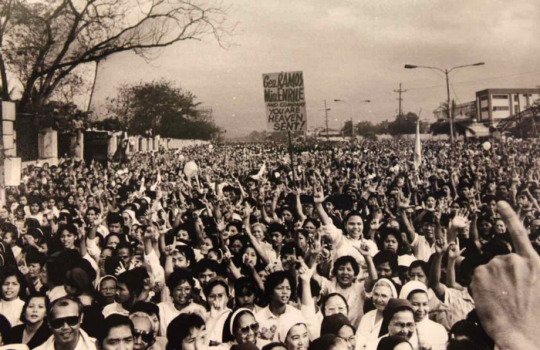
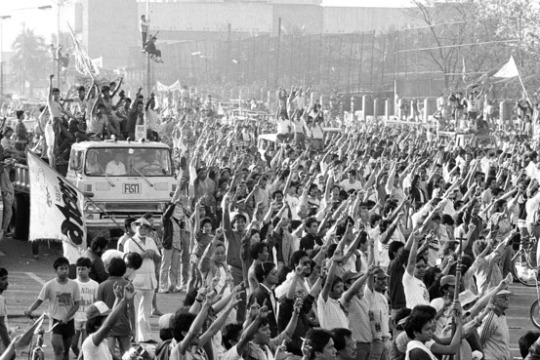
Considered a "bloodless revolution," not much violence went on among the masses as they unite and fight against the regime.
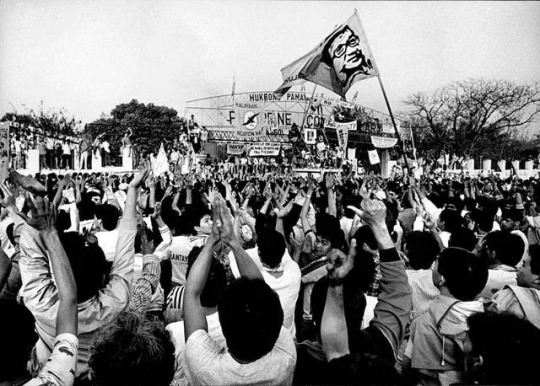
And so the winner is a woman! Corazon "Cory" Aquino becomes the next president (and the first female president) of the Philippines! She is the spouse of Benigno Aquino Jr., or Ninoy, who perished under an assassination in 1983. TIME Magazine named her Woman of The Year in 1986!
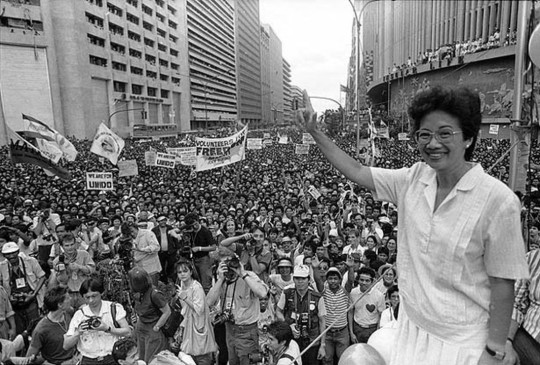

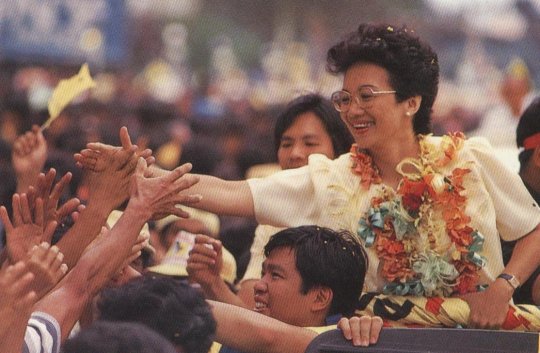
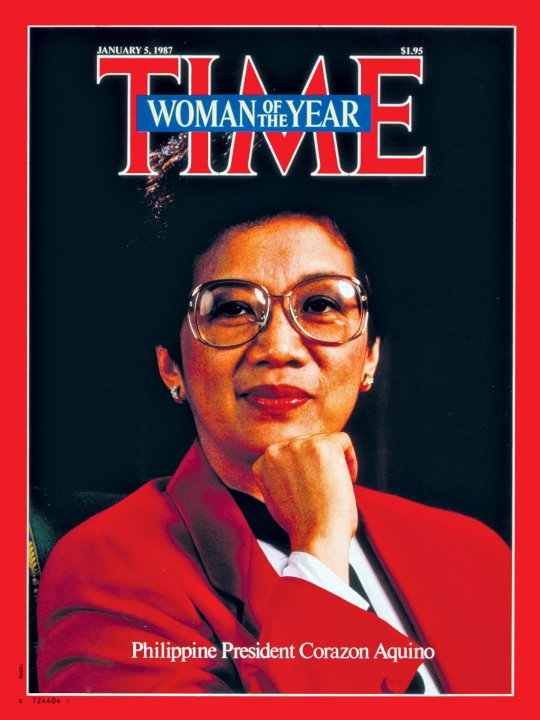
What's with the L? There are many symbols that came with the revolution. The L hand symbol is a sign for "Laban," meaning "Fight" in Filipino. Sadly, this has been desecrated by people who uses L as "Loser."

And why yellow? his is because of the presence of yellow ribbons in the revolution, a reference to the song "Tie A Yellow Ribbon." This symbol, too, has been desecrated by Israel to play the victim game.
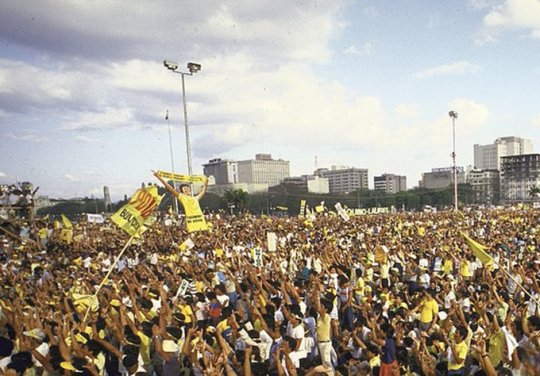
This song has also been the anthem of the revolution! I cannot find the original version but here's one of the most famous renditions.
I feel like I can never do my explanations for this event any justice, but it's always dear to my heart. Whenever I get sick and tired of fighting for this country due to corruption, my motivation are the people who fought for our freedom from the cruel Marcos regime.
And with Marcos' son in power, we have to make stronger reinforcements. We must prevent the repetition of the cruelty from his father's rule. Laban!
#history#philippines#philippine history#edsa#edsa revolution#1986#corazon aquino#cory aquino#revolution#marcos regime#ferdinand marcos#Spotify
14 notes
·
View notes
Text

#corazon aquino#cory aquino#11th president of the philippines#14th death anniversary#philippines#philippine history#history#filipino#august 1st
0 notes
Text
Oliver North's Counterinsurgency Ideas Shaping the World
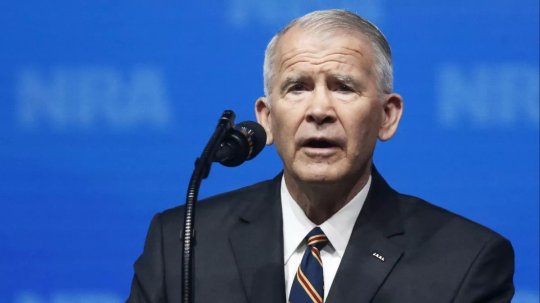
Towards the late 80s the United States became deeply involved in supporting the Philippine government's counterinsurgency efforts against communist and Muslim insurgent groups, pushing Corey Aquino toward a militant solution against these alleged terrorist threats. These efforts were meant to foster U.S. officials’ relationships to the Philippine government for the sake of providing military aid, training, and advice to the Philippine military and police forces, on behalf of their own [U.S.] interests. To this day, this remains the case. Oliver North, who was a key figure in the Reagan administration's efforts to combat leftist movements in Latin America, is likely to have been involved in shaping U.S. policy towards the Philippines during this period. Though there is no direct evidence to suggest that North played a significant role in the development of the Philippine government's specific counterinsurgency plan, the influence of his own counterinsurgency plans are undeniable, in the Philippines and even here in the U.S.
North is most notably a key figure in the Iran-Contra affair, in which the U.S. government secretly sold weapons to Iran and used the proceeds to fund the Contra rebels in Nicaragua. The Contras were a right-wing paramilitary group that fought against the leftist Sandinista government in Nicaragua. They also received funding from UC sources. The Iran-Contra led to North later being convicted of charges related to the sale of arms to Iran and the diversion of funds to the Contras. Despite this downfall, he remained a renowned international security expert and became a popular media figure, hosting a show on Fox News for years.
Why is he still widely respected by the Right, including the Unification Church, who rallied support for North during the Iran-Contra affair? Because his whole career was committed to the senseless extermination of alleged communists through “unconventional tactics.”
North's interest in so-called unconventional tactics and his willingness to circumvent traditional military channels were shaped by his experiences in Vietnam, where he served as a platoon commander. North was heavily involved in the Phoenix Program, a controversial counterinsurgency effort that targeted suspected communist sympathizers in Vietnam. The program involved the creation of a network of informants and paramilitary units, and the use of torture and assassination as tactics. This program is known for for having murdered thousands of suspected Viet Cong members, widely being criticized for its human rights abuses.
North’s experiences in Vietnam led him to see the world as a battleground between the forces of communism and democracy, and believed that the U.S. had a duty to use any means necessary to defeat the communist threat.
Following the war, he became a instructor at the Marine Basic School from 1969 to 1974; director of the Northern Training Area in Okinawa, Japan (1973–1974); plans and policy analyst with the manpower division at Headquarters Marine Corps from 1975 to 1978; and operations officer (S3) for 3rd Battalion, 8th Regiment, 2nd Marine Division at Camp Lejeune (1978–80). He graduated from the College of Naval Command and Staff at the Navy War College in 1981.
During the Reagan administration, Oliver North's counterinsurgency ideas were implemented in Latin America through a combination of military aid, covert operations, and support for right-wing regimes. One of the main ways that North's ideas were put into practice was through the provision of military aid to right-wing regimes and militias in the region. The Reagan administration provided billions of dollars in military aid to governments in countries such as El Salvador, Guatemala, and Honduras, which were fighting insurgent movements.
The military aid was often used to fund brutal counterinsurgency campaigns, which involved kidnapping, torture, and the use of death squads. These campaigns were carried out by government forces and paramilitary groups, which were often trained and equipped by U.S. military advisors. One example is the U.S. government’s training and support to the Salvadoran Army's Atlacatl Battalion, which was responsible for carrying out countless senseless murders and human rights abuses during the country's civil war.
Oliver North's ideas on counterinsurgency were not limited to Central America and other regions around the world. He also believed that these tactics could be applied in the United States itself, particularly in the event of a communist insurgency or other internal threat to national security.
North argued that the US government should create paramilitary units made up of civilians, which could operate outside of traditional military structures. These units would be trained and equipped by the government, but would be organized and led by civilians. North believed that this approach would allow the US to effectively combat insurgencies without triggering a constitutional crisis.
While there is no evidence that North's plan was ever fully implemented in the US, it is clear that his ideas had an impact on US counterinsurgency doctrine, leading to the development of right-wing militias through the 80s into the 2000s. Many of these groups have been infiltrated by the FBI, including the more “fraternity”-like organizations like the Proud Boys. Many of these groups were even founded by agents and “former” agents.
North's ideas on counterinsurgency are likely to have influenced the post-Marcos Philippine government as they developed their own counterinsurgency plan. After the People Power Revolution of 1986, the new Philippine government continued to wage war against communist and Moro organizations. Initially the new president Corazon (Cory) Aquino sought peace talks with the Communists, but due to the pressure of Moonie and CIA-supported figures, Aquino became convinced of a militarized approach to getting rid of the insurgent threat. The Philippine government developed a counterinsurgency plan that emphasized unconventional tactics and the use of paramilitary forces. The plan was developed in consultation with the International Security Council, a private security firm founded by former CIA agents, with support from various Moonie front organizations. The plan drew heavily on the ideas of Oliver North and other U.S. officials who had advocated for unconventional means of combatting insurgencies. It emphasized the use of paramilitary forces, covert operations, and other non-traditional tactics. As mentioned earlier, these plans remain in effect and have only become more violent.
#philippines#counterinsurgency#militia#cory aquino#corazon aquino#oliver north#politics#anti-communism#right-wing politics#cia#communist party of the philippines#the philippines#unification church in the philippines#philippine church#paramilitary#history
1 note
·
View note
Text
Corazón Aquino by Mª Isabel Sánchez Vegara. Illustrated by Ginnie Hsu

Age Recommendation: Early Primary Topic/ Theme: Politics, Biographic. Setting: Philippines, America Series: Little People, Big Dreams
Rating: 4/5
I really like Hsu's art for Corazon Aquino's entry into the LPBD series. The end pages represent the people, her people, the reason she chose to go into politics. That idea of democracy being of the people and for the people. The people are key to the process. There is a diversity in the people drawn on these pages. But I personally don't know enough about the demographics of the Philippines to make further comment on it. Hsu's illustrations in the book itself are lovely. They have this realism to the colouring that so many of these books don't seem to. The page where Maria Corazon is introduced is so beautiful and green, which feels like stereotypical Philippes. The scenes in America are distinct from those in the Philippines, the palette is different, more colour maybe. There is such a simple beauty in the illustrations on the pages showing 'Ninoy's' (Benigno Aquino) death. A memorial wreath and a family mourning in the rain. Everything is tied together well in all the illustrations. As always Sánchez Vegara wording is wonderful. Hitting the right tone and providing the right amount of information.
I picked this up purely because it's the LPBD series and Corazon Aquino's name was familiar. Corazon Aquino was the first female president of the Philippines to take power in 1986, holding it until 1992. Her son Benigno Aquino III was president between 2010-2016. Aquino is one of the women who followed a man in her life and her conscience and went into power (another well-known case is now disgraced Aung San Suu Kyi). There is nothing wrong with this it is all about a combination of honouring memory and love of people and democracy usually. These women are usually very interesting women.
#corazon aquino#book review#ma isabel sanchez vegara#little people big dreams#picture story#ginnie hsu#read 2022#biography#booklr#corazón aquino
0 notes
Text
SPOILER ILLU EP 8





#my candy love#amour sucre#amor doce#mcl new gen#jason mendal#mcl jason#amour sucré new gen#corazon de melon#mcl roy#mcl thomas#mcl devon#mcl amanda#mclng jason#devon okere#roy aquino#thomas rheault#amanda de lavienne#mcl ng spoilers
339 notes
·
View notes
Text
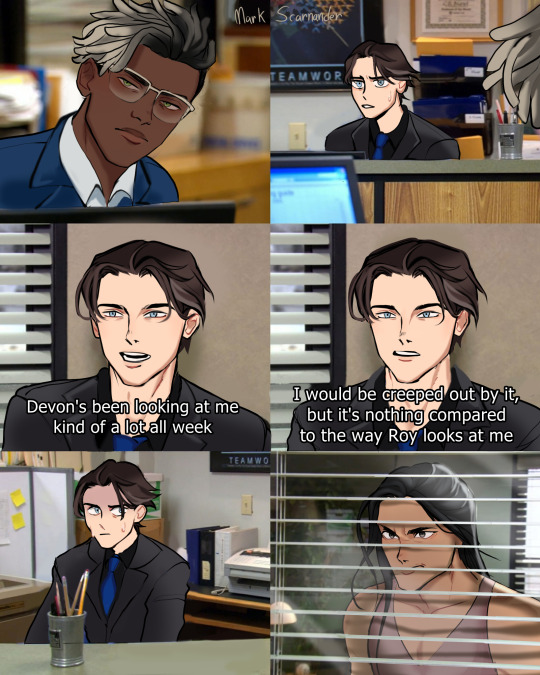
I needed to draw them
#my art#my candy love#my candy love new gen#corazon de melon#amour sucre#mcl new gen#mcl#mclng#mclng jason#mcl jason#jason mendal#roy aquino#devon okere
1K notes
·
View notes
Text

Roy & Eloise Halloween special with Roy as a merman and Eloise as a pirate!
#my art#digital art#artists on tumblr#original character#amor doce#my candy love#my candy love newgen#roy aquino#merman#pirate#couple#amor doce new gen#corazon de melon#oc#drawings#digital illustration
220 notes
·
View notes
Text

dolphin guy 🐬
#my art#mcl new gen#mclng roy#my candy love new gen#mclng#corazon de melon#roy aquino#mcl roy#beemoov#amour sucre#mcl#amour sucre new gen#might edit later i’m still not satisfied with the colors ;w;
238 notes
·
View notes
Text



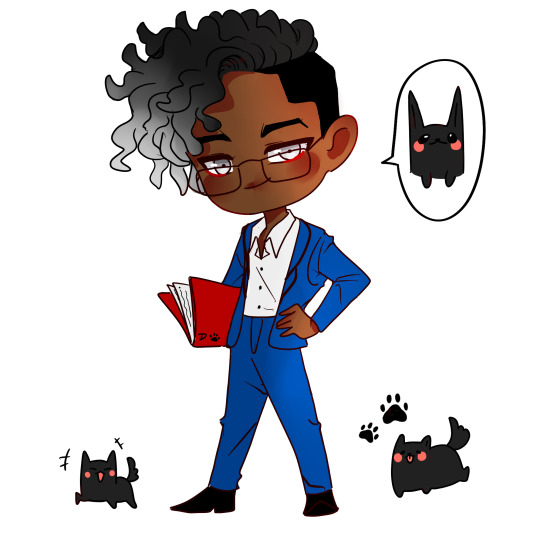
Amour sucre new gen boys. With some animals I thought fit them.
#amour sucre#mcl new gen#beemoov#my candy love#corazon de melon#amor doce#jason mendal#devon okere#roy aquino#thomas rheault#amour sucre fanart#mcl fanart
239 notes
·
View notes
Text
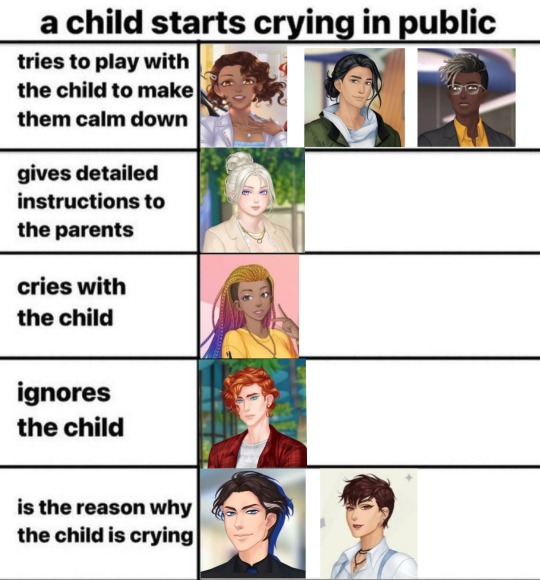

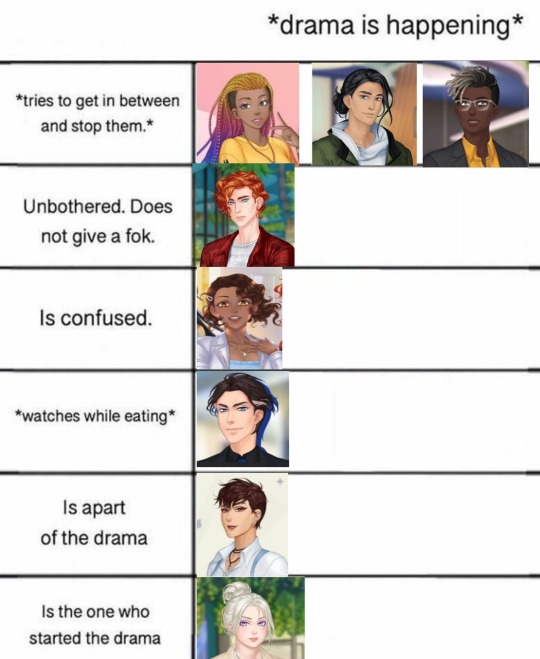





I'm already obsessed with this bunch of weirdos I swear I could make charts of them all day !! Some might not be in alignment with the characters since it's only the beginning and we don't know much about them. My favorite is clearly Thomas ( he is soo weird, I'm laughing my ass off everytime he speaks) !
Je suis déjà obsédée par cette bande de chelous, je pourrais vraiment passer ma vie à faire des charts sur eux !! C'est possible que parfois ça ne colle pas vraiment avec les personnages puisqu'on a pas encore beaucoup d'infos sur eux. En tout cas, mon préféré est clairement Thomas ( il est tellement bizarre, je suis pliée de rire à chaque fois) !
#my candy love#amour sucré#thomas rheault#amanda de lavienne#roy aquino#devon okere#chinomiko#beemoov#amour sucré new gen#my candy love new gen#corazon de melon#amor doce#jason mendal
248 notes
·
View notes
Text
Booboo Stewart is exactly how I think Roy would look irl









#mcl#my candy love#amour sucre#cdm#corazon de melon#amor doce#sweet amoris#mcl new gen#mclng#my candy love new gen#roy mcl#roy aquino
292 notes
·
View notes
Text






On this day in 2009, former president of the Philippines, Corazon "Cory" Aquino, died.
After the assassination of her husband Benigno Aquino Jr. in 1983, she rose against the cruel Marcos regime in the elections of 1986.
Winning against the cruel Marcos regime, she became the first female president in the Philippines. TIME named her the Woman of the Year in 1986!
One of my favorite political figures, I look up to her initiative to take down the cruelty and injustice.
I hope that one day, I'll be like her — not necessarily president but one of the figures that changed the course of history.
11 notes
·
View notes
Text
The difference between LIs plots for the Halloween event 2024 is hilarious
spoilers!!
Roy: wants to do a good job, but be nice to kids (we fix up his makeup)
Thomas: wants to do a good job, prevent everyone from getting to the candy jar (we fix each other's makeup)
Amanda: wants to do a good job, prevent people from getting to the candy jar, wants to scare everyone, but kids only a little and have them have sooome candy (we fix each other's makeup)
Devon: wants to do a good job for future job opportunities, just overall chill (we have to fix an emergency together)
Jason: scares the THE LIVING HELL out of everyone AND we stab him!!!
#amour sucre#corazon de melon#mcl#my candy love#mcl new gen#candy#devon#new genesis#amanda de lavienne#amanda#roy aquino#roy#thomas rheault#thomas#devon okere#jason mendal#jason#halloween#halloween 2024#halloween event#event#plot#plotline
70 notes
·
View notes
Text
Right-Wing Vigilantes Spreading in Philippines (1987)
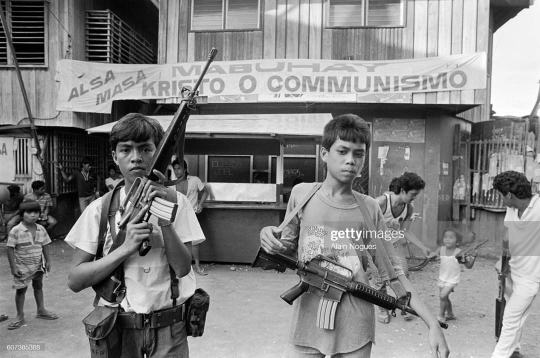
▲ Pictured: Members of Alsa Masa, an anti-communist vigilante group supported by CAUSA Bolld added for emphasis By Seth Mydans New York Times April 4, 1987
A year ago in the densely populated urban shantytown of Agdao, three men gunned down a notorious Communist hit man, raised their rifles and shouted, ''Arise, masses!''
With this now-legendary incident was born a right-wing vigilante group whose imitators are quickly spreading through the Philippines in a new approach to counterinsurgency.
Many military and Government leaders, including President Corazon C. Aquino and Gen. Fidel V. Ramos, the Chief of Staff, have endorsed the concept of anti-Communist vigilante groups, even as fears have grown that a new form of armed terror has taken root in this violent nation.
The central Government appears to have been caught unprepared as copycat groups spring up around the country, and observations on the scene clash with military assurances that they are spontaneous and unarmed. Outside Influence a Question
Interviews with officials in Manila, Cebu City and Davao, of which Agdao is a part, left unanswered questions about any possible outside coordination of these groups and their new strategy.
Among other organizations, Causa, the political arm of the Unification Church founded by the Rev. Sun Myung Moon, appears to have sought to capitalize on growing right-wing sentiment in the Philippines.
The original vigilante group, which has taken its name from that cry of vengeance, Alsa Masa, is armed and controlled by the local military commander in the city of Davao, which had become known as an urban ''laboratory'' for the insurgents.
With a system of checkpoints, armed patrols, taxation, propaganda, forced recruitment and summary justice that consciously mimics that of its Communist enemy, Alsa Masa has largely succeeded in driving the rebels from a city where, in many areas, they had taken effective control.
The Alsa Masa leader in Agdao, a 45-year-old tire dealer named Rolando Cagay, said his group raised money with weekly benefit dances.
Mrs. Aquino's secretary of local government, Jaime Ferrer, has ordered local officials throughout the country to form unarmed vigilante groups patterned on a village association called Nakasaka, or People United for Peace. Unarmed Only in Theory
Davao's military commander, Col. Franco M. Calida, dismissed the notion that unarmed groups could succeed, saying, ''This is an armed struggle.''
A reporter visiting Davao del Sur, a few miles south of Davao, where Nakasaka members man checkpoints with machetes and bows and arrows, found that some of them also carried pistols and homemade pellet guns.
There is an atmosphere of surprised relief in Davao at the quick retreat of open Communist force. The level of violence has sharply dropped in a city where three or more people were killed each day, either by the insurgents or the military.
But it is not clear to what extent the vigilante group was responsible for the rebels' retreat, or what its long-term success may be.
Colonel Calida said the withdrawal of the rebels from Agdao was a result of the success of ''deep penetration agents'' who touched off a violent reaction from the Communists. The rebels' fear of informers brought a series of killings in Agdao that alienated a previously supportive population. 'We Became Angry at Them'
''They were like gods here before,'' said Alejandro Amorado, standing at an Alsa Masa checkpoint in Agdao, speaking of the Communists. ''They killed the abusive people or drove them out of here. The people loved them.''
''But then they started killing even people who had not done anything -ice cream vendors, people who sold slippers,'' he said. ''We became angry at them.''
A local spokesman for the National Democratic Front, an umbrella organization that represents the Communists, acknowledged that the rebels had made mistakes and that Alsa Masa had been ''tactically effective'' in forcing them to return underground.
But the spokesman, who called himself Ka Gary, said several the vigilante groups were what he termed ''Alsa drama,'' putting on a show of converting to anti-Communism while they await a backlash that could ultimately play into their hands.
Some military officers expressed private concern that ''deep penetration'' could work both ways and that the weapons they issued to vigilante groups could fall into the hands of the insurgents. 'No Way to Be Neutral'
Meanwhile, Alsa Masa and its imitators have succeeded in polarizing the population.
''In the fight between democracy and Communism there is no way to be neutral,'' Colonel Calida said. ''Anybody who would not like to join Alsa Masa is a Communist.''
Alsa Masa members interviewed at checkpoints around the city said that each home was required to contribute one member to its nightly patrols and that the houses of those not cooperating might be painted with a red ''X.''
The Roman Catholic Church has also been caught up in the spreading polarization. The Auxiliary Bishop of Cebu, Msgr. Manuel Salvador, said recently, ''We really cannot blame these civilians who decide to arm themselves.''
As he spoke, vigilante groups were listing as targets other local churchmen who have been active in human-rights work. Priests of the Redemptorist order in Davao have been labeled ''Redempterrorists,'' and a group of Carmelite nuns has received threatening letters.
The police commander for Davao del Sur, Col. Jesus R. Magno, called the vigilante mobilization ''basically a psy-war operation.''
On a local radio station, a broadcaster named Jun Porras Pala read from a right-wing Causa manifesto and threatened doubters with retribution.
''We will exhibit your heads in the plaza,'' he told his critics in a recent broadcast. ''Just one order to our anti-Communist forces, your head will be cut off. Damn you, your brains will be scattered in the streets.''
It appears that the vigilante groups have carried out several killings as well as other acts of intimidation. Colonel Calida said 11 Communist rebels had been killed by vigilantes in Davao.
A former leftist militant who is setting up an Alsa Masa branch in Cebu City, Marianito Ventura, said: ''Of course if we come across a member of a sparrow unit, we liquidate him without notifying anybody. That is what they are doing to us.'' Sparrow units are Communist assassination squads.
He said his organization was useful to the military as a means of avoiding investigations of human rights abuses. ''We in the Alsa Masa don't give a damn about a review from the top,'' he said. Vigilantes in Other Regions
In recent weeks, vigilante groups have been quickly forming in other regions, adapting themselves to local conditions, and reports of abuses have begun to reach Manila.
On the sugar-growing island of Negros, planters have formed El Tigre, a network of armed groups whose threats this week drove 78 families to flee a rebel-influenced mountain area.
On the island of Cebu, a group called CACA, or Citizens Against Communism Army, has sent out armed patrols in remote areas that look in photographs like Communist rebel patrols and are said to have carried out attacks similar to rebel attacks.
In some areas of Mindanao and Cebu, right-wing groups have linked up with machete-wielding religious cultists called Tadtad, or Chop Chop, who believe they are immune to bullets and who ritually mutilate their victims.
Elsewhere, renegade military officers implicated in recent coup threats are said to have formed armed groups that advertise themselves as anti-Communist squads. Political Coercion Feared
Opponents of the vigilante groups warn that they provide the makings of private armies for a new generation of the warlords who have exercised local power in the Philippines.
''In a country with a very recent history of warlordism and fascism and right-wing military activism, I think this is a very dangerous phenomenon,'' said a senatorial candidate from Cebu, John Osmena. ''These groups can become the new instruments of political coercion.''
Already, the rapid growth of Alsa Masa throughout Davao has affected the tenor of local politics.
Few politicans openly criticize Alsa Masa, and even Mayor Zafiro Respicio, a human-rights exponent in the past, has found it expedient to endorse vigilantism., despite privateley expressed doubts.
''The whole city has turned right, hard right,'' said the managing editor of a local newspaper, Alberto Tesoro.
On a visit to Davao recently, President Aquino endorsed unarmed citizens' groups as a ''concrete manifestation of people power and an effective weapon against Communism without the use of firearms.''
But a political science professor at the University of the Philippines, Francisco Nemenzo, called this notion ''a mockery of the concept of people power,'' the term Mrs. Aquino gave last year to the peaceful protests that helped force President Ferdinand E. Marcos from power.
A correction was made on April 6, 1987: Monday, Late City Final Edition
#mindanao#the philippines#unification church#unification church in the philippines#philippine church#moonies#causa#anti-communism#alsa masa#politics#national democratic front#national democratic movement#communist party of the philippines#Corazon Aquino#cory aquino#communism#revolution
0 notes
Text









ㅤ ⌗ ˚₊‧ ♰ NEW GEN HALLOWEEN PACKS 🎃🧟♀️☠️
ㅤㅤㅤㅤㅤㅤㅤ
#amor doce#corazon de melon#mcl#my candy love#halloween#layouts#packs#new gen#mcl new gen#roy#thomas#devon#roy aquino#thomas rheault#devon okere#2024#amour sucre#headers#icons#amor doce icons
44 notes
·
View notes
Text
SPOILER ILLU EVENT HALLOWEEN 2024





#my candy love#amour sucre#amor doce#amour sucré new gen#corazon de melon#mcl new gen#jason mendal#mcl jason#mcl roy#mcl thomas#mcl amanda#thomas rheault#devon okere#roy aquino#amanda de lavienne
214 notes
·
View notes